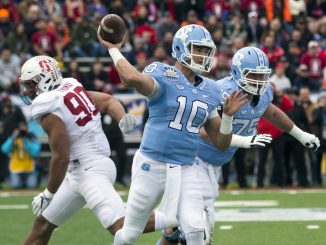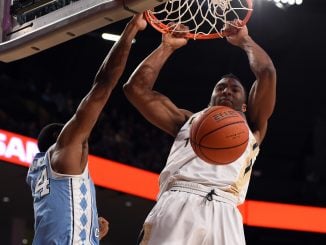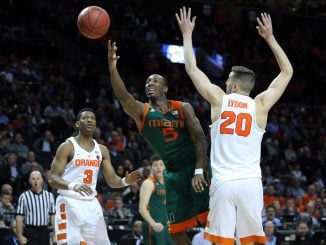
Cancer is something that will touch everyone’s life at some point. For those of us fortunate not to get a diagnosis or a scare, there are friends and relatives who won’t be so fortunate. Shawn Krest has been chosen by the American Cancer Society as one of the Real Men Wear Pink ambassadors for October, which is Breast Cancer Awareness Month. Each day of the month, he’ll be telling a story of how cancer has touched someone on one of the teams we root for. It could be a coach, a player, a retired legend or an arena worker. The disease doesn’t care how successful you are, how much money you have or, as we see in today’s post, are among the best players in baseball. To join in the fight against breast cancer, you can visit Shawn’s American Cancer Society page.
October is when the baseball season reaches its crescendo, with heroes and goats forged in the World Series.
People usually think of MLB players as the elite athletes making October memories. But players reach the fall classic through long seasons, standing day after day in the sun, wad of tobacco in their cheeks with late nights, poor diets and alcohol awaiting them postgame.
To commemorate the start of the MLB playoffs this month, we look at an All Star team of some of the sport’s biggest stars from recent years, as well as some journeymen who put in lengthy careers as role players. These 15 players consist of eight position players and seven pitchers.
The stats and trophy cases are impressive. They’ve combined for 35 All-Star Games in their 180 big league seasons. They’ve combined to win 11 World Series, twice winning postseason MVP awards. They’ve also won 10 Gold Gloves as the best fielder at their respective position, nine Silver Sluggers as the best hitter. They’ve also won a Rookie of the Year, two All-Star Home Run Derbys, two Roberto Clemente man of the year awards, a batting title and three Comeback Player of the Year awards.
And all 15 men were diagnosed with cancer while still active players and were able to return to the field after treatment.
Their 180 years in baseball were split almost evenly—100 seasons before their diagnosis, 80 after. They hit 622 of their combined 1,772 home runs and recorded 387 of their 617 wins after returning from the disease.
Here’s a look at the MLB Cancer Survivor All-Stars:
Six of the All-Stars are still active. In this first of this three-part series, we meet four of them.
Anthony Rizzo was one of the biggest acquisitions at the 2021 trade deadline when the Yankees acquired him from the Cubs.
As an 18 year old with the Class-A Greenville Drive, in April 2008, his ankles became swollen. After a few days, teammates became concerned and told his father, who sent his son to a doctor. He was diagnosed with Hodgkin’s lymphoma.
“It was definitely very shocking,” he told Web MD. ““I was 18 years old and on top of the world, playing professional baseball while all of my friends were off at college.”
He spent the year getting chemo, as well as encouragement. “We never had any doubts I would be cured,” he said. In September, he was pronounced cancer free.
One common theme with the Cancer Survivor All-Stars is that the new members of the club get encouragement from the players already on the team. While Rizzo was going through his battle, he spoke regularly with Jon Lester, a pitcher who has 200 wins and 2,488 strikeouts in his 16-year career. He was also traded at the 2021 deadline, to help the Cardinals make the playoffs.
As a 22-year-old rookie in September 2006, he was diagnosed with anaplastic large cell lymphoma. Two weeks earlier, Lester had been in a fender bender in Boston, and he thought his back pain was a result of the crash. When the Red Sox played in Seattle, however, he visited an uncle who happened to be a doctor. He discovered enlarged lymph nodes in Lester’s back and ordered an MRI.
“I thought I was in the best shape of my life coming in here, pitching every five days and pitching at Fenway Park — what could be better?” Lester told MedPage Today. “Obviously, there’s that denial: why, how could it be me, what did I do wrong?”
By December of that year, doctors had pronounced the disease in remission.
The third active player was also traded at the 2021 deadline. The Milwaukee Brewers bolstered their pitching rotation by dealing for Daniel Norris, the second time in Norris’ eight-year career he’s been traded at the deadline.
The last time was 2015, when he was playing after being diagnosed with cancer in April. His arm felt tired, and he got an MRI to see if he had a shoulder problem. Instead, they found a growth on his thyroid.
He decided to keep the diagnosis a secret and worked out a plan with doctors to put off treatment until after the season ended.
“My sister was having a baby at the time, so I kept it to myself for a while,” he explained.
He underwent surgery to remove the malignant growth from his thyroid in October. He was instructed to wait three weeks before working out, but boredom got to him after 10 days, and he began doing curls. By the end of the offseason, he’d gone surfing in Nicaragua and driven a 1978 Volkswagen van back and forth across the country.
In June 2019, Carlos Carrasco went to the doctor to see why he’d lost velocity on his fastball and was feeling so much arm fatigue. After a battery of tests at the Cleveland Clinic, he was diagnosed with chronic myeloid leukemia, a cancer of the blood.
Now with the Mets, he told the media on a preseason Zoom call this year that he allowed himself to think about the worst case … for about 10 seconds.
“That’s how long I was sitting there in the hospital thinking that I was going to die,” he wrote in an essay.
Then his wife, Kerry, told him, “You’re fine. You don’t have anything.” She’s repeated that phrase over and over again since.
“And that’s what I needed to hear,” he says. “Right now, I feel like I don’t have anything. … “I have kids, I have a wife, I have my parents, friends. I don’t want them to see me sad.”
There were some down moments. He tried to continue working with the team while getting treatment, but about a month after the diagnosis, he couldn’t throw a pitch to the catcher without bouncing it.
His pitching coach, Carl Willis, interrupted the bullpen session to give Carrasco a hug.
“I just remember him looking down and I think for the first time, (thinking to himself) ‘Why is this happening to me?’ And coming to grips with where he was at, “ Willis told the Cleveland media.
He returned to the mound in July of last year, throwing 95 MPH and striking out 10 batters in his first game back.
Previous stories in the series include the Carolina Hurricanes’ Stelio Mattheos, Ron Rivera, Brian Piccolo, Brett Butler and Quincy Monk. To donate to the American Cancer Society’s fight against cancer, visit the Real Men Wear Pink campaign page.



